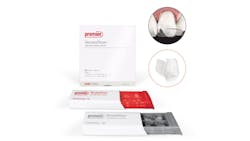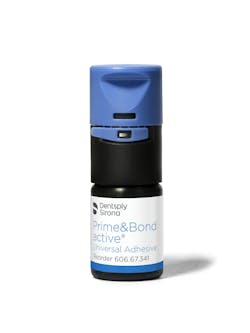Prime&Bond active
Several months ago, I was speaking at a state dental meeting. A lecture attendee came up to me after the program to introduce herself. She was a college student hoping to apply to dental school in the next 18 months. You could sense her excitement, but she was concerned because of her struggles in chemistry class. I assured her that I, too, struggled with various levels of undergrad chemistry and that it was a normal part of the dental education process. I let her know that she would pick it up and learn the things that are essential to being a dentist.
Of course, most of the chemistry we need to know involves materials and how we interact with them. Bonding is among the most chemistry-intense things we need to know. When we bond, we are asking a lot of our dental bonding agent. We are asking it to make a hydrophobic material stick to a hydrophilic substrate. Thankfully, we see advances in dental bonding agents every year. Prime&Bond active is a great advancement.
Prime&Bond is a flagship brand name in the dental adhesive game. The original Prime&Bond has been around for decades, and over the years we’ve seen upgrades like Prime&Bond elect. The newest iteration is Prime&Bond active. This is a universal adhesive designed to be used on both direct and indirect restorations. It can be used in any etching mode (total etch, self-etch, or selective etch.) Anyone who reads this column regularly will know I love the selective-etch technique and would recommend it with Prime&Bond active. Like most other universal bonding agents, it has a low film thickness and a low rate of post-op sensitivity.
What sets Prime&Bond active apart from some other adhesives is how resilient it is in challenging conditions. While other bonding agents require just the right level of moisture in the dentin, Prime&Bond active utilizes “Active Moisture Control” technology. By using an alcohol-based solvent and water in the adhesive, Prime&Bond active can handle dentin that is a bit too wet or too dry and still result in a great bond. The alcohol can serve to help overcome the surface tension of too-wet dentin to ensure a good bond and an even layer. In a situation of the dentin being too dry, the water can serve to remoisten the collagen fibrils, giving a more even hybrid layer. Either way, you’re covered!
Reliability and consistent performance are key for our bonding procedures. Prime&Bond active gives us that in addition to flexibility of real-world, pragmatic bonding situations where we don’t always have perfect conditions. In addition, it pairs directly with Calibra Ceram cement, making a simple workflow for you and your team. Prime&Bond active is a great choice for your dental bonding agent. Double to the left center field gap for Dentsply Sirona!
VeneerNow
I recently joined the American Academy of Cosmetic Dentistry (AACD). It was something I should have done years ago, but just never got around to signing up. The reason I made it a point to do it now is because of their current president, Dr. Adamo Notarantonio. He might be the most talented cosmetic dentist in the world. In addition to that, he’s an extremely kind and humble person with a big heart. Seeing people like him in leadership made me want to be a part of the organization. One of the biggest parts of being a member of the AACD is working toward accreditation. This is an incredibly difficult road that involves meticulous case documentation and skill. It is not for the faint of heart. In the list of cases needed for accreditation is a resin veneer case. UGH! Not that. Anything but that. There is nothing more challenging in dentistry than a resin veneer case. Thankfully, we are seeing some tools on the market to help with these cases. VeneerNow Injectable Matrix System by Premier is one of those tools.
VeneerNow Injectable Matrix System is an excellent solution for quickly creating quality, natural-looking chairside resin veneers and anterior restorations. They are designed for easy use by enabling composite injection with easy cleanup, minus all the lab work that previously “injection molded” workflows required. VeneerNow Injectable Matrix System is composed of individual clear matrices with a small porthole. The matrices fit over a tooth and allow you to inject resin through the porthole onto the tooth while the matrix holds the shape. Once the resin is injected, it can be cured through the clear matrix. The matrix has a full anatomic design, so the injected resin composite replicates the natural tooth shape. The natural cervical line in the matrices helps to create a precise, anatomical emergence profile. The side wings of the matrices keep the matrix stable and in place on the tooth, and since the inside of the matrix is extremely smooth, we get a restoration that is smooth and void free, making finishing and polishing a breeze!
There are two different sizes and eight different shapes of VeneerNow matrices. The sizes are small/medium and medium/large. The shapes are teeth 5-12. With a full VeneerNow Injectable Matrix kit, you could create resin veneers from first premolar to first premolar with ease and grace! This kit can be used with either flowable or packable composite, although I would probably recommend heating packable composite if that’s what you decide to use, just to ensure it flows well through the matrix and around the tooth.
I probably have no prayer of ever being an AACD-accredited dentist, but it is nice to know that companies like Premier are making it easier than ever to deliver quality resin composite veneers. Triple down the right field line for VeneerNow!
20 years of IPS e.max by Ivoclar
I frequently think of what my dad’s dental practice was like in the 1970s. I’m sure that his days were filled with standard, everyday restorative dental procedures like amalgams, gold castings, extractions, and removable prosthodontics. In the few times he got to perform an esthetic procedure, it was probably a PFM. Maybe he got to do some of the early Adaptic restorations. I know that he certainly did not have the options or outcomes we have today. We are privileged to be practicing during such exciting times. We are truly in our esthetic era as an industry.
The leader of ushering in that esthetic era has definitely been Ivoclar. I graduated from dental school 20 years ago. In that time, the name IPS e.max has stood for esthetics and strength. Hundreds of millions of these revolutionary restorations have been placed by dentists all over the world. In 2025, we celebrate 20 years of IPS e.max, and what a 20 years it has been.
In the early 2000s, Ivoclar was already well-known in the all-ceramics game. IPS Empress became a mainstay of esthetic dentists, and IPS Empress II only improved on that. As 2005 rolled around, Ivoclar debuted a new product meant to take the beauty of IPS Empress to a new level of strength. That is when IPS e.max came into our lives. e.max is short for “Empress to the Max,” and it certainly lives up to that name by taking the beauty of leucite-reinforced glass ceramics but giving it excellent strength characteristics. The new material, lithium disilicate, would be the start of an entire new category of products. Those early IPS e.max restorations were all analog, but great materials cannot be held back by technology advancement. Today, IPS e.max offers a wide digital fabrication portfolio, and it is probably the most used same-day chairside ceramic material ever.
The data on IPS e.max is overwhelming. One article in the Journal of Prosthetic Dentistry found a 0.17% failure rate of IPS e.max restorations on posterior teeth over a 16.9-year period.1 Unreal! IPS e.max can do it all.
As we reflect on the millions of lives changed by this revolutionary material over the past 20 years, we must thank the good people who brought it into our lives. Ivoclar is a company that stands on core values and delivers phenomenal products. They have made our lives better with the products and materials they produce, in addition to all the patients they have affected through us. Remember Freddie Freeman’s walk-off World Series Game 1 winning grand slam? That’s what score IPS e.max should get!
Editor's note: This article appeared in the June 2025 print edition of Dental Economics magazine. Dentists in North America are eligible for a complimentary print subscription. Sign up here.
Reference
- Malament KA, Margvelashvili-Malament M, Natto ZS, Thompson V, Rekow D, Att W. Comparison of 16.9-year survival of pressed acid etched e.max lithium disilicate glass-ceramic complete and partial coverage restorations in posterior teeth: performance and outcomes as a function of tooth position, age, sex, and thickness of ceramic material. J Prosthet Dent. 2021;126(4):533-545.
About the Author
Joshua Austin, DDS, MAGD
Joshua Austin, DDS, MAGD, is a graduate and former faculty member of the University of Texas Health Science Center at San Antonio School of Dentistry. Author of Dental Economics’ Pearls for Your Practice column, Dr. Austin lectures nationally on products, dental technology, online reputation management, and social media. He maintains a full-time restorative dentistry private practice in San Antonio, Texas. You may contact Dr. Austin at [email protected].
Updated June 21, 2023




